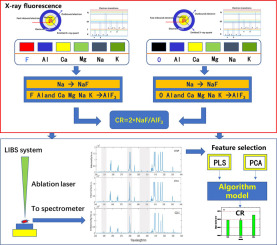当前位置:
X-MOL 学术
›
Spectrochim. Acta B. At. Spectrosc.
›
论文详情
Our official English website, www.x-mol.net, welcomes your feedback! (Note: you will need to create a separate account there.)
Measurement of the molecular ratio of Aluminum electrolytes using laser-induced breakdown spectroscopy
Spectrochimica Acta Part B: Atomic Spectroscopy ( IF 3.3 ) Pub Date : 2020-02-01 , DOI: 10.1016/j.sab.2019.105753 Hui Lu , Xiaojun Hu , Liang Ma , Meng Li , Bin Cao
Spectrochimica Acta Part B: Atomic Spectroscopy ( IF 3.3 ) Pub Date : 2020-02-01 , DOI: 10.1016/j.sab.2019.105753 Hui Lu , Xiaojun Hu , Liang Ma , Meng Li , Bin Cao

|
Abstract Electrolytes cause the electrolytic reaction of alumina, producing aluminum. Their main component is cryolite. The molecular ratio of electrolytes is an important index to judge the acidity and alkalinity of industrial electrolytes, which are also critical for aluminum electrolysis. The molecular ratio is numerically equal to the molar ratio of NaF to AlF3. The goal of this study was to measure the molecular ratio of electrolytes via laser-induced breakdown spectroscopy (LIBS). First, the micro-morphology, element distribution, and phase structure of industrial electrolytes were analyzed. Second, an artificial neural network (ANN), a support vector machine (SVM), random forest regression (RFR), and gradient-boosting regression (GBR) algorithms were used to establish calibration models for original spectral data and normalized spectral data respectively, and the performances of different models were compared. Calibration models were used to predict independent samples. Finally, partial least squares (PLS) and principal component analysis (PCA) were used to reduce the dimension of the spectral data and screen the variables. Multiple linear regression (MLR), PLS, ANN, and SVM were used to build prediction models based on the new variables screened out, and the generalization abilities of different models were investigated using the leave-one-out cross-validation (LOOCV) method. For the PLS-ANN and PCA-SVM models, the root mean square errors (RMSEs) were 0.100 and 0.136, while the mean relative error (MRE) was 1.204% and 3.142%, respectively. The calibration models were used to test the independent samples, and the measurement results were compared and analyzed. In conclusion, this work provides a temporary new method of testing the electrolyte molecular ratio.
中文翻译:

使用激光诱导击穿光谱测量铝电解质的分子比
摘要 电解质引起氧化铝的电解反应,生成铝。它们的主要成分是冰晶石。电解液的分子比是判断工业电解液酸碱度的重要指标,对铝电解也很关键。分子比在数值上等于 NaF 与 AlF3 的摩尔比。本研究的目的是通过激光诱导击穿光谱 (LIBS) 测量电解质的分子比。首先,分析了工业电解质的微观形貌、元素分布和相结构。二、人工神经网络(ANN)、支持向量机(SVM)、随机森林回归(RFR)、利用梯度提升回归(GBR)算法分别对原始光谱数据和归一化光谱数据建立校准模型,并比较不同模型的性能。校准模型用于预测独立样本。最后,采用偏最小二乘法(PLS)和主成分分析法(PCA)对光谱数据进行降维,筛选变量。基于筛选出的新变量,采用多元线性回归(MLR)、PLS、ANN和SVM构建预测模型,并使用留一法交叉验证(LOOCV)方法考察不同模型的泛化能力. 对于 PLS-ANN 和 PCA-SVM 模型,均方根误差 (RMSE) 分别为 0.100 和 0.136,而平均相对误差 (MRE) 分别为 1.204% 和 3.142%,分别。使用校准模型对独立样本进行测试,并对测量结果进行比较和分析。总之,这项工作提供了一种测试电解质分子比的临时新方法。
更新日期:2020-02-01
中文翻译:

使用激光诱导击穿光谱测量铝电解质的分子比
摘要 电解质引起氧化铝的电解反应,生成铝。它们的主要成分是冰晶石。电解液的分子比是判断工业电解液酸碱度的重要指标,对铝电解也很关键。分子比在数值上等于 NaF 与 AlF3 的摩尔比。本研究的目的是通过激光诱导击穿光谱 (LIBS) 测量电解质的分子比。首先,分析了工业电解质的微观形貌、元素分布和相结构。二、人工神经网络(ANN)、支持向量机(SVM)、随机森林回归(RFR)、利用梯度提升回归(GBR)算法分别对原始光谱数据和归一化光谱数据建立校准模型,并比较不同模型的性能。校准模型用于预测独立样本。最后,采用偏最小二乘法(PLS)和主成分分析法(PCA)对光谱数据进行降维,筛选变量。基于筛选出的新变量,采用多元线性回归(MLR)、PLS、ANN和SVM构建预测模型,并使用留一法交叉验证(LOOCV)方法考察不同模型的泛化能力. 对于 PLS-ANN 和 PCA-SVM 模型,均方根误差 (RMSE) 分别为 0.100 和 0.136,而平均相对误差 (MRE) 分别为 1.204% 和 3.142%,分别。使用校准模型对独立样本进行测试,并对测量结果进行比较和分析。总之,这项工作提供了一种测试电解质分子比的临时新方法。


























 京公网安备 11010802027423号
京公网安备 11010802027423号